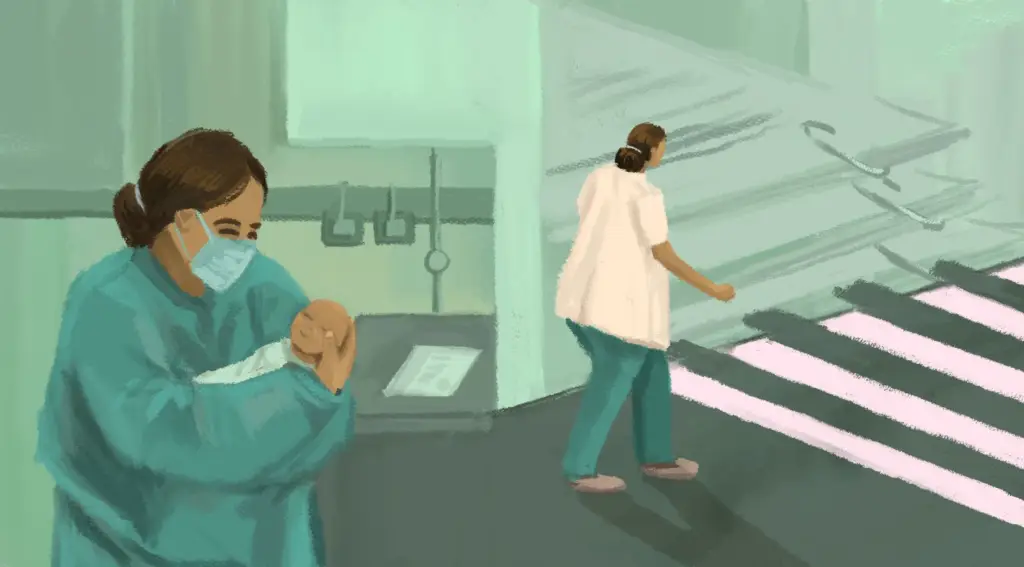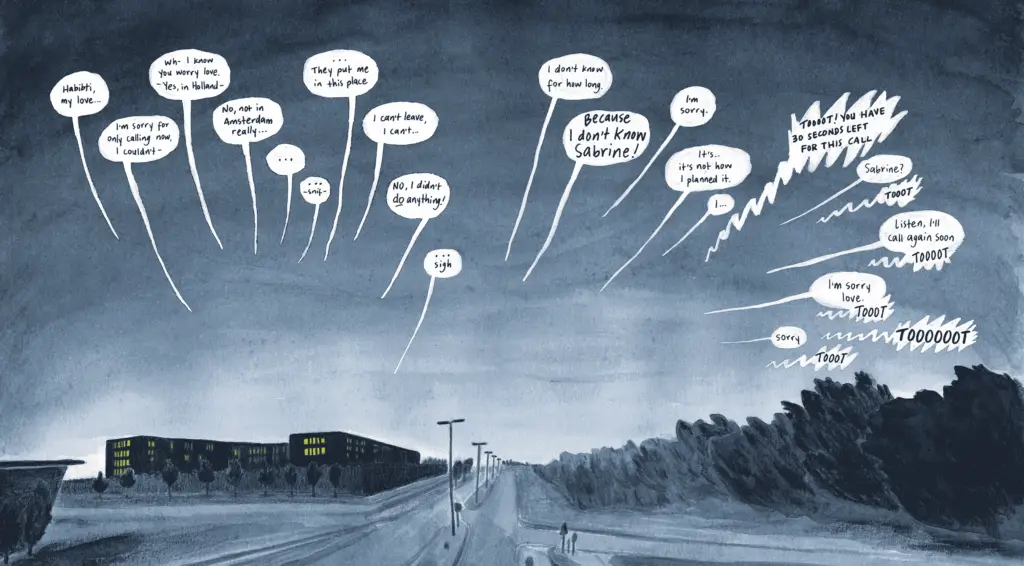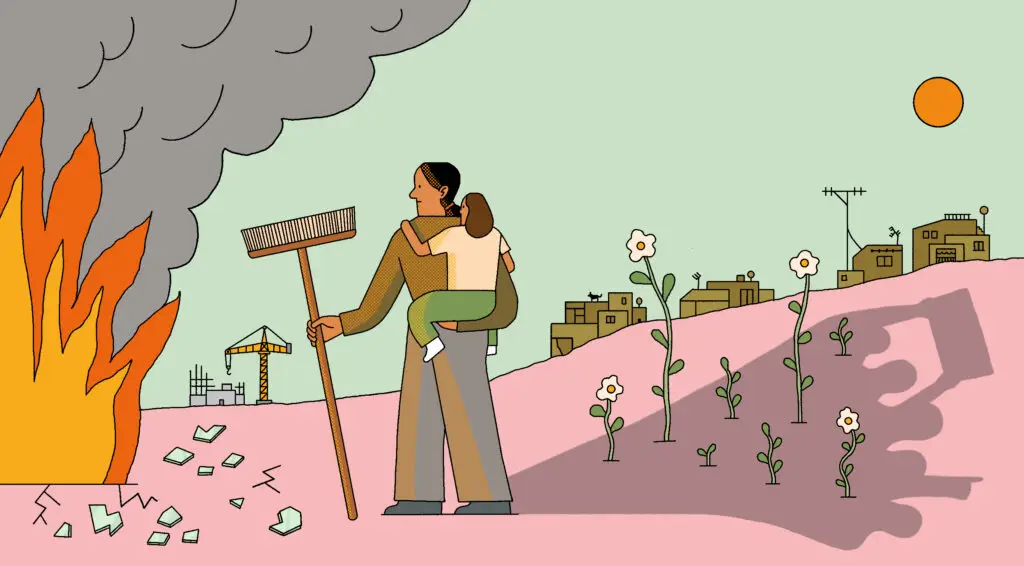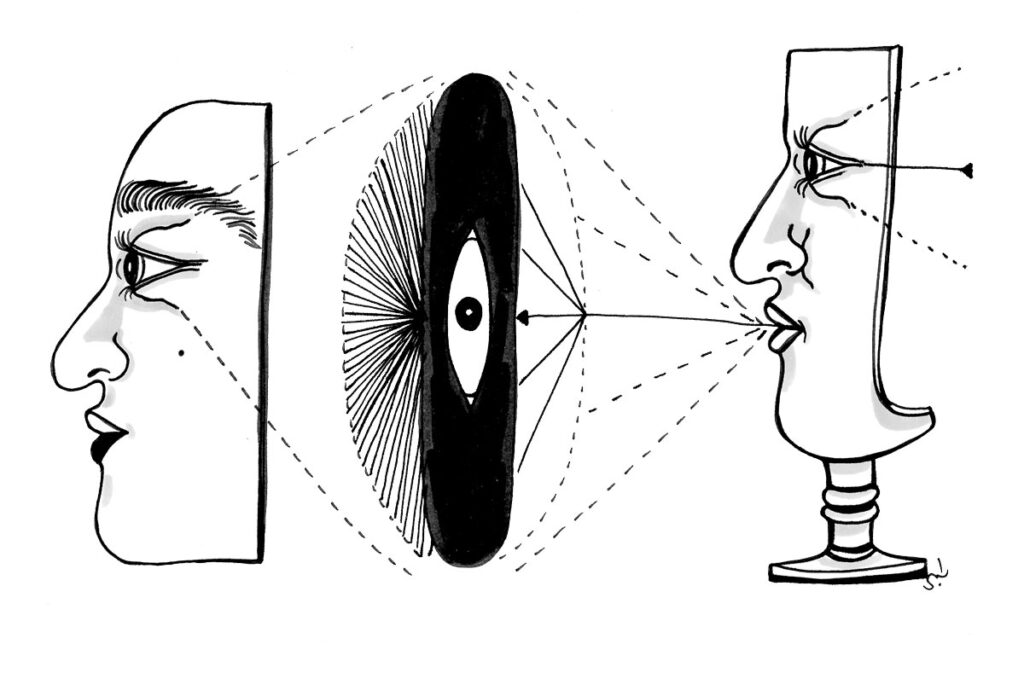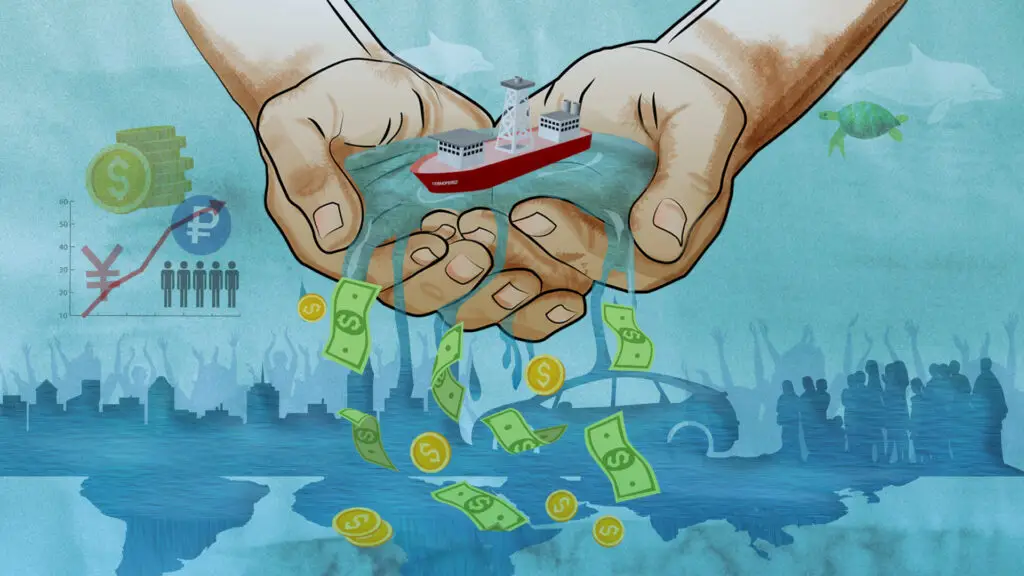Read this article in Italian.
If she passes her next exam, Dr. Angelina Sanchez’s medical diploma will officially be recognized in Italy. But unlike many young medical students eagerly waiting for the results of their qualifying exams months after finishing classes, she graduated from medical school five years ago. But because the University of Zulia is located in Maracaibo, Venezuela, a process that takes Italians months took her years.
As her classes wrapped up, she was living through the chaos of a week-long blackout that plunged 18 Venezuelan states into darkness, and believed her diploma would be the ticket to a better life away from her troubled country. “I worked so hard to graduate,” explains Angelina. “My goal was to obtain my diploma so that I could leave the country.” This blackout was neither the first nor the last of Venezuela’s crises, including skyrocketing gasoline prices, severe water shortages, and protracted political instability.
She soon learned that a diploma in one of the most competitive degrees from a prestigious university in Venezuela was just a piece of paper in Italy.
She arrived in Europe in 2019, crossing 10,000 kilometers from Maracaibo to Bogota, Colombia, before finally reaching Milan with only twenty-five dollars left in her wallet. Her two older brothers eagerly awaited her arrival, as did an obstacle course of bureaucracy and discrimination. Angelina was swiftly confronted with the harsh reality of being an immigrant in Italy. “Nobody tells you how difficult it is to be a young woman and a migrant,” she said.
A Europe-wide data investigation by Lighthouse Reports, an investigative outlet, in collaboration with Financial Times, El País, and Unbias the News, has revealed that while educated migrants like Angelina have a hard time in breaking into the medical field in Italy, she would have likely faced similar if not as severe challenges in almost every country in Europe. The investigation showed that despite major shortages of skilled labor, immigrants with college degrees are not working at their skill level in almost every country, a problem termed “brain waste” by the European Union. Italy has one of the highest rates of brain waste of the countries studied, making it one of the worst places in Europe for educated migrants to look for a job.
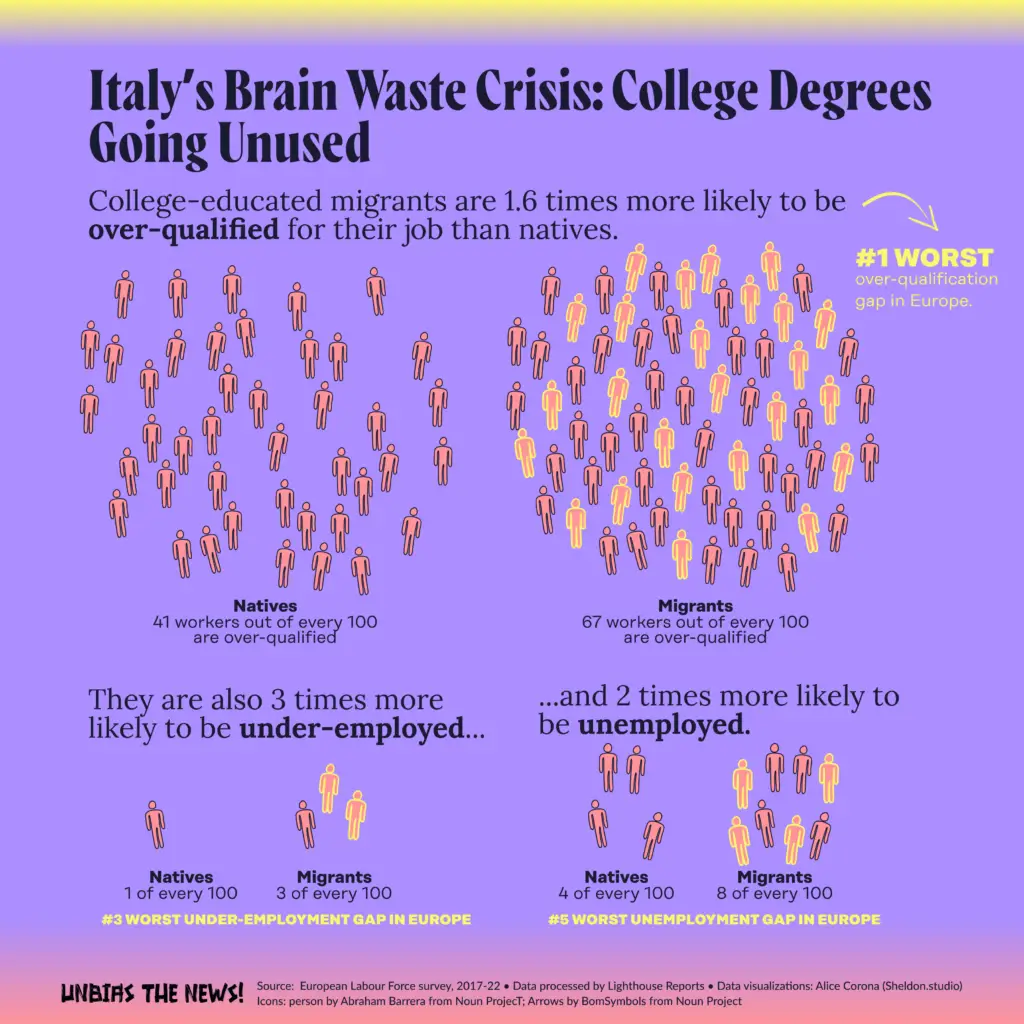
The investigation shows that when migrants land a job in Italy they face a disheartening reality: the gap in overeducation between college-educated migrants and college-educated natives is the highest in Europe, and migrants are also more likely to be underemployed, meaning that they end up working part-time despite being available and wishing to work additional hours.
Educated migrants in Italy may be “lucky” to have any job at all. The data analysis shows that the unemployment rate for college-educated migrants is 7.6%, and the gap between unemployed migrants and unemployed natives with a college degree is one of the highest in Europe.
All these gaps translate into an unsettling outcome: Italy has the biggest wage difference between college-educated natives and college-educated migrants in Europe.
Harsh beginnings
With a pale face framed by long black hair and a soft voice, Angelina looks younger than her twenty-nine years. As she recounts the taxing series of precarious jobs she had to take to help sustain her family upon arrival in Italy, her voice hardens.
During her time transitioning from one waitressing job to another in one of the most exclusive areas of Milan, Angelina was paid an unstable income between 500 and 1200 Euros per month. “I am really angry, because they play with the needs of people,” said the doctor about her employers during that time. She often worked 40 hours a week on her feet, catering to the needs of the exclusive clientele of Milan’s city center.
Like her, many migrants who are overqualified for their jobs are likely to work as waiters and bartenders, but they also end up doing domestic work, including as hotel and office cleaners and helpers, or as shop salespersons, Lighthouse’s analysis reveals.
And these jobs often carry additional burdens.
On one occasion, her supervisor even went so far as to unbutton her shirt right before she served male clients. Despite the demeaning treatment, Angelina had to keep the job. She and her brothers struggled to make ends meet in the most expensive city in the country. “I was absolutely desperate, I did not have money or anything else,” she said.
As the investigation shows, in Italy each person who is overqualified for their job misses out on approximately 4,640 Euros annually on average, compared to someone whose job matches their education level. The economic loss increases to 7,878 Euros for people who are underemployed.
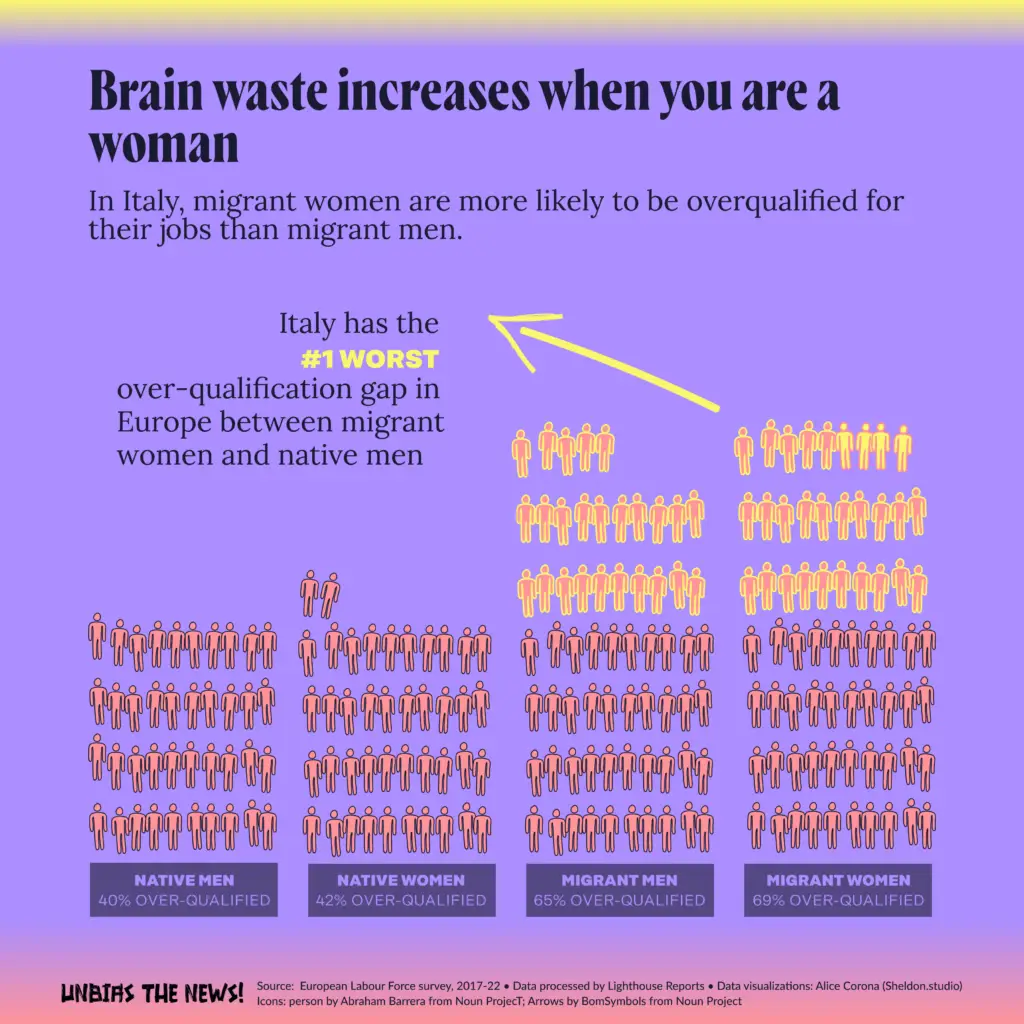
Turning Point: Covid
It wasn’t until the onset of the Covid-19 pandemic that Angelina’s skills were finally recognized, if not her degree. In the first months of 2020, Italy was the first country in Europe to have an outbreak of the virus. People worldwide watched in horror as footage of triage was broadcast from Italian hospitals, previews of what would come as the virus began its worldwide spread. In March of that year, the country reached the highest death toll in the world due to Covid-19 in relation to its population. That is when things began to change for Angelina.
In view of the dramatic demand for medical professionals, the Italian government issued a special decree that temporarily allowed hospitals to hire foreign personnel even without a recognized diploma.
Eager to put her skills to use, Angelina sent a letter to the regional council, but her offer of help went nowhere. Through the intervention of an NGO, the doctor got her first chance to practice in a hospital in the southern Italian city of Palermo.
That initial experience opened doors for her in the midst of the pandemic, ultimately leading to a position at an elder care facility in Milan. Angelina’s first time practicing her profession was during a crisis where her patients bore the highest risks. “I had to wear one of those astronaut-like suits every day,” she recounts, “We had two floors for Covid patients.” The doctor’s entry into the field she trained for resulted from extraordinary circumstances: it took a global health crisis and emergency legislation for her to finally step foot inside a healthcare facility.
Many immigrants struggle to secure employment commensurate with their academic qualifications, especially in fields where jobs are scarce.
According to Lighthouse’s investigation, in Italy, immigrants holding degrees in business and social sciences are most likely to be overqualified. These overqualified migrants are most likely to end up working as domestic workers, including hotel and office cleaners and helpers, or as personal care workers in health services.
A Europe-wide phenomenon
Angelina would likely have encountered similar challenges in any other country in Europe. According to Lighthouse Report’s Europe-wide data, nearly half of college-educated migrants find themselves working in a position below their qualifications, while only a third of natives are working jobs that they are overqualified for. This gap means that with the same educational qualifications, natives are more likely to land jobs that meet their qualifications than migrants. Even when controlling for Italian language skills, migrants who speak Italian are 19.5% more likely to be over-qualified than natives.
The unemployment rate among college-educated migrants is nearly double that of natives, across Europe too: 6.3% of college-educated migrants are unemployed compared to 3.3% of college-educated migrants. A small percentage of college-educated migrants, equivalent to 3.3%, also reports being underemployed, indicating they work fewer hours than desired, compared to 2.1% of native graduates. So across Europe, migrants with college degrees are working worse jobs, have no jobs or are working fewer hours than natives with the same educational background.
In Italy migrants who have not gotten their degrees recognized are more likely to be overqualified than migrants who have. The Italian gap is the highest in Europe.
Degree recognition is necessary to apply for some regulated professions, such as those that require state exams or registration with a professional government body before you can practice it. The investigation shows that in Italy, 54% of college-educated natives work in regulated professions compared to 39% of migrants, a gap larger than the European average.
Despite the importance of degree recognition, the process is costly, highly bureaucratic, and discouraging. For Angelina, gathering all the necessary documents, along with the mandatory translation of her degree in her country of origin, cost her more than $4000. “It is only thanks to my job as a doctor that I could go through with it, I had enough money to get the necessary documentation,” said Angelina. This dilemma is faced by countless migrants: needing a doctor’s salary to afford the recognition of a medical diploma.
The bureaucratic labyrinth, in Italian
The mismatch between the dreams migrants carry across borders and the harsh reality of Italian migration policies leaves a trail of untapped potential and unfulfilled ambitions. Yet, Italy suffers from a lack of skilled labor, and has fallen behind in productivity since the early 1990s. So why does a nation with a desperate need for economic growth leave skilled migrants sitting on the sidelines?
The first barrier to entry is language. However, securing academic recognition for diplomas obtained abroad is a major obstacle for most. Antonella Martini, president of Cimea, the Italian organization in charge of diploma conversion, highlights that translating competencies across different education systems is a complex challenge. “A professional in the sector must have knowledge of the regulations and structure of the foreign training system and his own, of the sources he can draw on to find clear and relevant information, as well as being continually updated on the policies affecting the country,” explains Martini.
Cimea receives about 65 thousand applications yearly. The majority of them are successful, with an 85% approval rate. People seeking degree recognition often encounter issues revolving around what happens before the verdict: a waiting time of up to five months, bureaucratic costs and confusion about where to send applications in the first place. On the organization’s international university database, multiple links to foreign academic institutions, including the section dedicated to Venezuela, are non-existent or broken.
EU comes first
Not all migrants face the same challenges. Following her graduation in Romania, Dr. Catalina Cristofor made her way to Tuscany in 2007, where she converted her diploma and embarked on a public health specialization the following year. “I’m convinced that if one is determined, they can achieve anything they set their minds to,” said the Romanian doctor.
Since 2002, Italy has implemented an automated diploma recognition system for Europeans, streamlining the bureaucratic process and significantly easing the path for EU nationals to work in Italy.
Catalina Cristofor believes she was among the first Romanian doctors to benefit from this provision. In possession of an EU-recognized medical degree, she started working right away as a doctor on call in Tuscany.
Catalina’s move to Italy coincided with Romania’s accession to the European Union. However, she still waited over a year to receive confirmation of her medical diploma’s conversion, during which time Catalina dedicated herself to studying Italian. “I could only manage it thanks to my family’s financial support,” she explained.
Once in Italy, Catalina had to juggle taking care of her first son and a full-time job. Her story is one of success, but not all healthcare workers are on equal footing when competing in the Italian labor market.
Systemic and individual discriminatory practices
After three years in an extended care facility on the periphery of Milan, Angelina decided, reluctantly, to quit her job. The stress of managing up to two hundred hospital cases a day through long and demanding shifts was offset by the joy of daily interactions with patients and their families.
A toxic workplace finally prompted Angelina to quit, she said.. “They made my life impossible, until I had to resign,” explained the doctor as her voice broke. From passive-aggressive language to daily insults and unfair treatment, doctor Sanchez explained how going to work had destroyed her sense of safety. The hospital manager insisted Angelina work overtime without extra compensation, and often described her as a good-for-nothing that “worked as a cashier would.” When Angelina refused, the care facility work environment got even worse. “I feel like the burden of all the toxicity has been lifted off my chest,” she said.
Episodes of individual discriminatory practices, akin to Angelina’s experience, add to the already numerous challenges faced by migrants under Italy’s bureaucratic system. A 2023 study showed that workplace bullying in Italy, discriminatory and otherwise, was particularly prevalent in the healthcare sector. A 2021 study showed that experiences of perceived workplace discrimination were significant enough to affect immigrants’ mental health. Things are especially complicated for those who apply for a work-related visa, and thus may find it hard to leave a workplace, even when experiencing discrimination or bullying.
Rules for an impossible game
Every three years, Italy establishes a finite number of foreigners allowed to immigrate for job opportunities. Between 2023 and 2025, the government set the limit at around 150 thousand people per year. According to the Ministry of Labor, businesses estimate they would need almost 50 percent as many people to fill specialized positions, for a volume of 436 thousand workers. Among those, the health system alone is looking for at least 70 thousand migrant workers. Employers can make a request to the government to hire migrant workers, and are supposed to be matched with a qualified aspiring candidate. However, it is a lengthy process that can take up to a year and does not allow candidates to visit Italy for preliminary interviews.
“How can someone be the ideal candidate if they are allowed in the country seven or eight months after an employer’s request?” asks lawyer Alberto Guariso, member of ASGI, a law association specialized in supporting immigrants.
In 2023, legislation became even more stringent, with only nationals coming from countries that had specific agreements with Italy, including those who campaign against so-called illegal migration, as eligible candidates for work-related immigration.
For the most part, employment conditions do not substantially improve over the years for migrants who decide to stay in Italy. Those who have been in the country for less than 10 years are more likely to be overqualified than college-educated natives. The gap in overqualification is smaller when comparing natives to migrants who arrived in Italy more than 10 years ago, but it is still the highest gap in Europe.
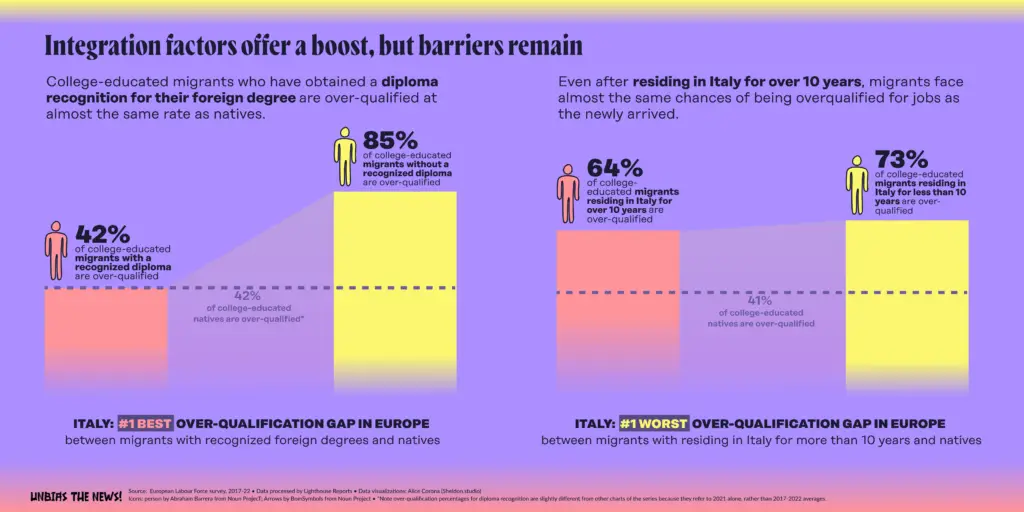
In Italy, talented migrants’ exclusion seems to be exacerbated, rather than mitigated, by provisions at the state level.
In particular, migrants on a “high qualification visa” can’t work in public hospitals and governmental institutions, which tend to accept applicants only with Italian or EU nationality, such as doctor Cristofor, whose specialization in public health management came in handy during the pandemic. The pandemic prompted the state to allow for temporary exceptions.
According to Guariso, it would be sufficient to change just one article of labor law to make the public sector permanently more inclusive. “It’s a relatively easy problem to solve, but no one wants to get their hands on it,” said the lawyer. Perhaps if the political will existed, Angelina could have gotten another job rather than starting back at square one.
The rhetoric of adaptability
Sociologist of migration Laura Zanfrini points out that the issue stems from the Italian government’s ideology that pushes migrant work as a complement rather than competition to natives. “Even the pro-immigrant discourse in Italy insists a lot on adaptability, on the fact that they do those jobs we don’t want to do,” explains Zanfrini, “but it is not a discourse that facilitates the recognition of added value.” In other words, if not to perform low paid jobs, it is hard for many Italians to see why foreigners would be needed.
Whether it is a government strategy or the result of sloppy politics, Italy increasingly fails to attract talented foreigners. This is particularly true for those in the health sector, where over a third of migrants work a job below their competence.
“We have a lot of complaints coming from people who could and would like to practice as doctors in Italy, but that get caught up in this big mess. After a while they rightly get fed up and go to Germany, England, or elsewhere where they can earn more money.”
Alberto Guariso
When she left Romania, many of Catalina’s university colleagues looked upon her with envy, viewing Italy as a dreamy yet inaccessible destination in their collective imagination. It was challenging for her to maintain friendships as her university peers opted to go to Northern Europe. “They took the easier road,” Catalina remarked.
In the long run, the hurdles she and her family faced have smoothed out, and they see a future in Italy. For the first time, both Catalina and her husband are employed in the healthcare sector in Bolzano, and her two children are steadily integrating into their new school. “There’s nothing like the sun and a plate of pasta for lunch,” she added, half-jokingly.
Fighting for a future
Approximately 200 km to the south, Angelina has no intention of leaving Italy either. After waiting for over a year, she finally received a cautiously optimistic response from the Italian Ministry of Health about her diploma recognition. However, one of her submitted documents, a photocopy, was deemed invalid. She was given three months to send the original, which was in her hometown in northern Venezuela. The Sanchez family decided to take the opportunity to finally move their father to Italy. The plan was for him to bring the crucial missing document to secure Angelina’s future as a practicing doctor.
A few weeks before departure, on April 13rd, at 69, her father passed away from cancer, a condition he had kept secret from his daughter and two sons. Angelina attended the funeral remotely.
In the midst of the grieving process, her mother traveled 687 kilometers from Maracaibo to Caracas to send the original document using the fastest possible shipping service.
It remains uncertain whether the extraordinary efforts of the Sanchez family, cumulating over the past five years, will be enough to secure Angelina a well-paid job in Italy. “I come from a family of immigrants, hard workers, fighters, and so was my dad,” says Angelina, “it’s his memory that pushes me to keep going.”
About the author
Giada Santana is an Italian-Dominican journalist reporting on international stories involving politics, environment, and human rights violations. She holds a Master’s Degree in Journalism and International Affairs from SciencesPo University in Paris.
Read more on migration

What happens when ordinary people become human rights defenders? At the edge of Europe’s last primevil forest in Poland, volunteers shoulder the burden their state resists by helping those who cross the border from Belarus to seek asylum.




